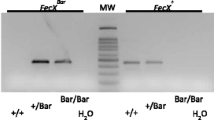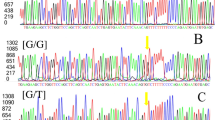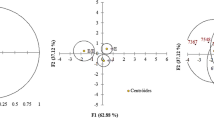Abstract
The growth and differentiation factor 9 (GDF9) intervenes in the fecundity and prolificacy of the ewe, which are important variables that participate in the reproductive efficiency of a flock. The objective of this study was to evaluate the influence of FecGE mutation of the gene GDF9 in the natural response of the manifestation to estrus, return to estrus, ovulation rate, pregnancy, lambing, prolificacy, and fecundity rate in Pelibuey ewes, during the anestrus period. The sequences of the exon 2 of the gene GDF9 were obtained from blood samples collected in Whatman™ FTA™ cards from 42 multiparous Pelibuey ewes with reproductive records. For this purpose, the quality of the sequences was analyzed and the polymorphisms and genotypes were searched for. The ewes were grouped according to their group: (a) homozygous or Embrapa (GG), (b) wild (AA), and (c) group without gene (sG). All the ewes studied manifested estrus behavior, but none showed signs of return to estrus after natural mating (p > 0.05); likewise, the pregnancy and lambing rates (p > 0.05) did not show differences between groups. However, the group GG presented higher ovulation rate, prolificacy, and fecundity rate (p < 0.05), compared to groups AA and sG. Although no differences were found in the manifestation of estrus, return to estrus, and percentage of pregnancy and lambing in females from the genotypes studied, the homozygous ewes GG presented 1.22 and 1.72 more corpus luteum (CL, p < 0.05), prolificacy of 0.7 and 0.7, and fecundity rate of 0.8 and 1.0 more lambs per ewe (p < 0.05) than the ones produced by the wild-type AA and sG groups, respectively.

Similar content being viewed by others
References
Abdoli, R., Zamani, P., Mirhoseini, S. Z., Ghavi Hossein-Zadeh, N., & Nadri, S. (2016). A review on prolificacy genes in sheep. Reproduction in Domestic Animals, 51(5), 631–637. https://doi.org/10.1111/rda.12733
Arroyo, L. J., Gallegos-Sánchez, J., Villa-Godoy, A., Berruecos, J. M., Perera, G., & Valencia, J. (2007). Reproductive activity of Pelibuey and Suffolk ewes at 19° north latitude. Animal Reproduction Science, 102(1–2), 24–30. https://doi.org/10.1016/j.anireprosci.2006.09.025
Cansino-Arroyo, G., Herrera-Camacho, J., & Aké-López, J. (2009). Tasas de concepción, fertilidad y prolificidad en ovejas de pelo alimentadas con dietas enriquecidas con ácidos grasos poliinsaturados. Universidad y Ciencia Trópico Húmedo, 25(1), 181–185. Retrieved from http://www.scielo.org.mx/scielo.php?script=sci_arttext&pid=S0186-29792009000200008&lng=es&tlng=es
Colpos. (2016). Reglamento para el uso y cuidado de animales destinados a la investigación en el Colegio de Postgraduados. In Reglamento para el uso y cuidado de animales en experimentación (pp. 1–16).
De la Isla-Herrera, G., Aké-López, J. R., Ayala-Burgos, A., & González-Bulnes, A. (2010). Efecto de la condición corporal y la época del año sobre el ciclo estral, estro, desarrollo folicular y tasa ovulatoria en ovejas Pelibuey mantenidas en condiciones de trópico. Veterinaria México, 41(3), 167–175. Retrieved from http://www.scielo.org.mx/scielo.php?script=sci_arttext&pid=S0301-50922010000300001&lng=es&tlng=es
Dixon, A. B., Knights, M., Winkler, J. L., Marsh, D. J., Pate, J. L., Wilson, M. E., … Inskeep, E. K. (2007). Patterns of late embryonic and fetal mortality and association with several factors in sheep. Journal of Animal Science, 85(5), 1274–1284. https://doi.org/10.2527/jas.2006-129
Edgar, R. C. (2004). MUSCLE: Multiple sequence alignment with high accuracy and high throughput. Nucleic Acids Research, 32(5), 1792–1797. https://doi.org/10.1093/nar/gkh340
El-Halawany, N., Kandil, M. O., Shawky, A. A., Al-Tohamy, A. F., El-Sayd, A. Y., Abdel-Shafy, H., … Jiang, Z. (2018). Investigating the effect of GDF9, BMP15, BMP6 and BMPR1B polymorphisms on Egyptian sheep fecundity and their transcripts expression in ovarian cells. Small Ruminant Research, 165(1), 34–40. https://doi.org/10.1016/j.smallrumres.2018.06.010
Fabre, S., Pierre, A., Mulsant, P., Bodin, L., Di Pasquale, E., Persani, L., … Monniaux, D. (2006). Regulation of ovulation rate in mammals: Contribution of sheep genetic models. Reproductive Biology and Endocrinology, 4, 1–12. https://doi.org/10.1186/1477-7827-4-20
Fernández, A. D., Ibáñez, W., & De Mora, M. (2006). Efecto del momento del servicio, número de servicio y período entre servicios, sobre la fertilidad de ovejas Merino sincronizadas con servicio a corral. Producción Ovina, 18, 49–55. Retrieved from http://www.produccion-animal.com.ar/produccion_ovina/produccion_ovina/62-Fernandez_Abella_3.pdf
Galloway, S. M., McNatty, K. P., Cambridge, L. M., Laitinen, M. P. E., Juengel, J. L., Jokiranta, T. S., … Ritvos, O. (2000). Mutations in an oocyte-derived growth factor gene (BMP15) cause increased ovulation rate and infertility in a dosage-sensitive manner. Nature Genetics, 25(3), 279–283. https://doi.org/10.1038/77033
García, E. (2004). Modificaciones al sistema de clasificación climática de Köppen. (I. de Goegrafía-UNAM, Ed.) (Quinta edi). México. Retrieved from http://www.igeograf.unam.mx/sigg/utilidades/docs/pdfs/publicaciones/geo_siglo21/serie_lib/modific_al_sis.pdf
Garcia-Guerra, A., Wiltbank, M. C., Battista, S. E., Kirkpatrick, B. W., & Sartori, R. (2018). Mechanisms regulating follicle selection in ruminants: lessons learned from multiple ovulation models. Animal Reproduction, 15, 660–679. https://doi.org/10.21451/1984-3143-AR2018-0027
Gastelum-Delgado, M. A., Avendaño-Reyes, L., Álvarez-Valenzuela, F. D., Correa-Calderóna, A., Meza-Herrera, C. A., Mellado, M., & Macías-Cruz, U. (2015). Circannual estrous behavior in Pelibuey ewes under arid conditions of Northwestern of Mexico. Revista Mexicana En Ciencias Pecuarias, 6(1), 109–118. Retrieved from http://www.scielo.org.mx/pdf/rmcp/v6n1/v6n1a8.pdf
Hanrahan, J. P., Gregan, S. M., Mulsant, P., Mullen, M., Davis, G. H., Powell, R., & Galloway, S. M. (2004). Mutations in the genes for oocyte-derived growth factors GDF9 and BMP15 are associated with both increased ovulation rate and sterility in Cambridge and Belclare sheep (Ovis aries). Biology of Reproduction, 70(4), 900–909. https://doi.org/10.1095/biolreprod.103.023093
Juengel, J. L., Hudson, N. L., Heath, D. A., Smith, P., Reader, K. L., Lawrence, S. B., … Mcnatty, K. P. (2002). Growth differentiation factor 9 and bone morphogenetic protein 15 are essential for ovarian follicular development in sheep 1. Biology of Reproduction, 67(6), 1777–1789. https://doi.org/10.1095/biolreprod.102.007146
Kleemann, D. O., & Walker, S. K. (2005). Fertility in South Australian commercial Merino flocks: relationships between reproductive traits and environmental cues. Theriogenology, 63(9), 2416–2433. https://doi.org/10.1016/j.theriogenology.2004.09.052
Kumar, S., Stecher, G., & Tamura, K. (2016). MEGA7: Molecular Evolutionary Genetics Analysis Version 7.0 for Bigger Datasets. Molecular Biology and Evolution, 33(1), 1870–1874. https://doi.org/10.1093/molbev/msw054
Macías-Cruz, U, Sánchez-Estrada, T. J., Gastelum-Delgado, M. A., Avendaño-Reyes, L., Correa-Calderón, A., Alvarez-Valenzuela, F., … Mellado, M. (2015). Actividad reproductiva estacional de ovejas Pelibuey bajo condiciones áridas de México. Archivos de Medicina Veterinaria, 47, 381–386.
Macías-Cruz, Ulises, Gastélum, M. A., Álvarez, F. D., Correa, A., Díaz, R., Meza-Herrera, C. A., … Avendaño-Reyes, L. (2016). Effects of summer heat stress on physiological variables, ovulation and progesterone secretion in Pelibuey ewes under natural outdoor conditions in an arid region. Animal Science Journal, 87(3), 354–360. https://doi.org/10.1111/asj.12430
Marai, I. F. M., El-Darawany, A. A., Fadiel, A., & Abdel-Hafez, M. A. M. (2008). Reproductive performance traits as affected by heat stress and its alleviation in sheep. Tropical and Subtropical Agroecosystems, 8(3), 209–234.
Martinez, M. F., McLeod, B., Tattersfield, G., Smaill, B., Quirke, L. D., & Juengel, J. L. (2015). Successful induction of oestrus, ovulation and pregnancy in adult ewes and ewe lambs out of the breeding season using a GnRH+progesterone oestrus synchronisation protocol. Animal Reproduction Science, 155, 28–35. https://doi.org/10.1016/j.anireprosci.2015.01.010
Mullen, M. P., & Hanrahan, J. P. (2014). Direct evidence on the contribution of a missense mutation in GDF9 to variation in ovulation rate of Finnsheep. PLoS ONE, 9(4). https://doi.org/10.1371/journal.pone.0095251
Mulsant, P., Lecerf, F., Fabre, S., Schibler, L., Monget, P., Lanneluc, I., … Elsen, J.-M. (2001). Mutation in bone morphogenetic protein receptor-IB is associated with increased ovulation rate in Booroola Mérino ewes. Proceedings of the National Academy of Sciences of the United States of America, 98(9), 5104–5109. https://doi.org/10.1073/pnas.091577598
Nicol, L., Bishop, C. S., Pong-Wong, R., Bendixen, C., Holm, L.-E., Rhind, M. S., & Mcneilly, S. A. (2009). specific GDF9 gene results in sterility in Thoka sheep. Reproduction, 138(6), 921–933. https://doi.org/10.1530/REP-09-0193
Orisaka, M., Orisaka, S., Jiang, J.-Y., Craig, J., Wang, Y., Kotsuji, F., & Tsang, B. K. (2006). Growth Differentiation Factor 9 Is Antiapoptotic during Follicular Development from Preantral to Early Antral Stage. Molecular Endocrinology, 20(10), 2456–2468. https://doi.org/10.1210/me.2005-0357
Otsuka, F., McTavish, K. J., & Shimasaki, S. (2011). Integral role of GDF-9 and BMP-15 in ovarian function. Molecular Reproduction and Development. https://doi.org/10.1002/mrd.21265
Pérez-Ruiz, E., Gallegos-Sánchez, J., Cortez-Romero, C., Segura-León, Obdulia L. Salinas-Ruíz, J., & Salazar-Ortiz, J. (2020). FecGE mutation in Pelibuey sheep. Animal Genetics, 51(1), https://doi.org/10.1111/age.12912
Petrie, A., & Watson, P. (2013). Statistics for Veterinary and Animal Science. (WILEY-BLACKWELL, Ed.) (Third Edit). United Kingdom. Retrieved from www.wiley.com/go/petrie/statisticsforvets
Rosa, H. J. D., & Bryant, M. J. (2003). Seasonality of reproduction in sheep. Small Ruminant Research, 48(3), 155–171. https://doi.org/10.1016/S0921-4488(03)00038-5
Sadighi, M., Bodensteiner, K. J., Beattie, A. E., & Galloway, S. M. (2002). Genetic mapping of ovine growth differentiation factor 9 (GDF9) to sheep chromosome 5. Animal Genetics, 33(3), 244–245. https://doi.org/10.1046/j.1365-2052.2002.t01-11-00876.x
SAGARPA (Secretaría de Agricultura, Ganadería, Desarrollo Rural, Pesca, y Alimentación,), . (2001). Norma oficial Mexicana NOM-062-ZOO-1999, Especificaciones técnicas para la producción, cuidado y uso de los animales de laboratorio. Diario Oficial de La Federación, 22 Agosto, 107–165. Retrieved from https://www.gob.mx/cms/uploads/attachment/file/203498/NOM-062-ZOO-1999_220801.pdf
SAS Institute Inc., Cary, NC, U. (2013). SAS 9.4 Statements ®. (S. Institute, Ed.) (9.4 Statem). Retrieved from http://citeseerx.ist.psu.edu/viewdoc/download;jsessionid=239E4F5E2E39CF2164C9BAD96900EA01?doi=10.1.1.353.6870&rep=rep1&type=pdf
Silva, B. D. M., Castro, E. A., Souza, C. J. H., Paiva, S. R., Sartori, R., Franco, M. M., … Melo, E. O. (2010). A new polymorphism in the growth and differentiation factor 9 (GDF9) gene is associated with increased ovulation rate and prolificacy in homozygous sheep. Animal Genetics, 42, 89–92. https://doi.org/10.1111/j.1365-2052.2010.02078.x
Souza, C. J. H., McNeilly, A. S., Benavides, M. V., Melo, E. O., & Moraes, J. C. F. (2014). Mutation in the protease cleavage site of GDF9 increases ovulation rate and litter size in heterozygous ewes and causes infertility in homozygous ewes. Animal Genetics, 45(5), 732–739. https://doi.org/10.1111/age.12190
Strauss, J. F., & Williams, C. J. (2019). Ovarian Life Cycle. In J. S. R. B. A. Gargiulo (Ed.), Yen & Jaffe’s Reproductive Endocrinology: Physiology, Pathophysiology, and Clinical Management: Eighth Edition (Eighth Edi, pp. 167-205.e9). Elsevier Inc. https://doi.org/10.1016/B978-0-323-47912-7.00008-1
Ungerfeld, R. (2009). The induction of oestrus in ewes during the non-breeding season using pre-used CIDRs and oestradiol-17β treatment. Small Ruminant Research, 84(1–3), 129–131. https://doi.org/10.1016/j.smallrumres.2009.06.011
Vacca, G. M., Dhaouadi, A., Rekik, M., Carcangiu, V., Pazzola, M., & Dettori, M. L. (2010). Prolificacy genotypes at BMPR 1B, BMP15 and GDF9 genes in North African sheep breeds. Small Ruminant Research, 88, 67–71. https://doi.org/10.1016/j.smallrumres.2009.11.005
Våge, I. D., Husdal, M., Kent, P. M., Klemetsdal, G., & Boman, A. I. (2013). A missense mutation in growth differentiation factor 9 (GDF9) is strongly associated with litter size in sheep. BMC Genetics, 14(1), 1–8. https://doi.org/10.1186/1471-2156-14-1
Valencia, J., Porras, A., Mejía, O., Berruecos, J. M., & Trujillo, J. (2006). Reproductive Activity of Pelibuey Ewe During the Anoestrus Season: Revista Científica, FCV-LUZ, XVI(2), 136–141
Acknowledgements
The authors thank the National Council for Science and Technology for the scholarship of the PhD studies of the first author and Universidad Autónoma Chapingo for the support given in the use of the sheep.
Funding
Colegio de Postgraduados provided financial support to the research.
Author information
Authors and Affiliations
Contributions
CMG conducted the study. HVH analyzed data. JGS participated along the experiment. LATA corrected the previous version of the paper. CMBP and ABV revised and edited final version of the manuscript. CCR designed research, analyzed data, and wrote first version of the paper. All authors read and approved the manuscript.
Corresponding author
Ethics declarations
Ethical statement
Animal management was done taking into account the ethical requirements for the use of animals in experimentation, recommended by the Mexican Official Norm (NOM-062-ZOO-1999) (SAGARPA 2001) regarding technical specifications for the production, care, and use of laboratory animals in agreement with regulations for the use and care of research animals, approved by the General Academic Council of Colegio de Postgraduados, Mexico (Colpos 2016).
Conflict of interest
The authors declare no competing interests.
Additional information
Publisher’s note
Springer Nature remains neutral with regard to jurisdictional claims in published maps and institutional affiliations.
Rights and permissions
About this article
Cite this article
Muñoz-García, C., Vaquera-Huerta, H., Gallegos-Sánchez, J. et al. Influence of FecGE mutation on the reproductive variables of Pelibuey ewes in the anestrus period. Trop Anim Health Prod 53, 328 (2021). https://doi.org/10.1007/s11250-021-02755-7
Received:
Accepted:
Published:
DOI: https://doi.org/10.1007/s11250-021-02755-7




